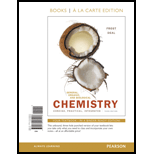
a.
To determine:
Identify yogurt as solution or colloid.
Introduction:
A homogenous mixture is known as solution. A solution consists of solute and solvent. The solute is evenly dispersed substance in another substance called solvent. Solution can be homogenous mixture of solid, liquid or gases. Colloid is a homogenous mixture of molecules of one substance that are dispersed in a second substance. These molecules aggregate to form large particles such as micelle but do not dissolve in water.
b.
To determine:
Identify cola drink as solution or colloid.
Introduction:
A homogenous mixture is known as solution. A solution consists of solute and solvent. The solute is evenly dispersed substance in another substance called solvent. Solution can be homogenous mixture of solid, liquid or gases. Colloid is a homogenous mixture of molecules of one substance that are dispersed in a second substance. These molecules aggregate to form large particles such as micelle but do not dissolve in water.
c.
To determine:
Identify gasoline as solution or colloid.
Introduction:
A homogenous mixture is known as solution. A solution consists of solute and solvent. The solute is evenly dispersed substance in another substance called solvent. Solution can be homogenous mixture of solid, liquid or gases. Colloid is a homogenous mixture of molecules of one substance that are dispersed in a second substance. These molecules aggregate to form large particles such as micelle but do not dissolve in water.
Want to see the full answer?
Check out a sample textbook solution
Chapter 8 Solutions
GENERAL ORGANIC+BIO...(LL)-W/MOD.ACCESS
- > Organic Functional Groups Naming and drawing alkyl halides structure CI Br CI CI Explanation Check 2 name 1-chloro-2,4,9-trimethylnonane CI 2-iodo-2,3-dimethylbutane FEB 19 € E M tv MacBook Airarrow_forwardCan you please explain to me this problem im very confused and lost. Help me step by step and in detail im soo lost.arrow_forward2) There are many forms of cancer, all of which involve abnormal cell growth. The growth and production of cells, called cell proliferation, is known to involve an enzyme called protein farnesyltransferase (PFTase). It is thought that inhibitors pf PFTase may be useful as anticancer drugs. The following molecule showed moderate activity as a potential PFTase inhibitor. Draw all stereoisomers of this compound. HO OHarrow_forward
- Considering rotation around the bond highlighted in red, draw the Newman projection for the most stable and least stable conformations when viewed down the red bond in the direction of the arrow. Part 1 of 2 H₁₂C H H Draw the Newman projection for the most stable conformation. Select a template to begin. Part 2 of 2 Draw the Newman projection for the least stable conformation. G 心arrow_forwardpersonality of each of them in terms of nucleophile vs. electrophile (some can be considered acids/bases but we are not looking at that here). Note you may have to use your growing intuition to figure out the personality of one of the molecules below but I believe in you! Rationalize it out based on what we have called strong versus weak electrophiles in past mechanisms. Consider using the memes below to help guide your understanding! A OH O B CH3 C Molecule A: [Select] Molecule B: [Select] Molecule C: [Select] Molecule D: [Select] > H D OHarrow_forward4) Which oxygen atom in the structure below is most basic / nucleophilic? Please explain by discussing the electron density around each oxygen atom. Show at least three resonance structures for the compound. оогоarrow_forward
- Can you show me this problem. Turn them into lewis dot structures for me please and then answer the question because I cant seem to comprehend it/ The diagrams on the picture look too small I guess.arrow_forwardThe fire releases 2.80 x 107 Joules of heat energy for each liter of oil burned. The water starts out at 24.5 °C, raising the water's temperature up to 100 °C, and then raises the temperature of the resulting steam up to 325 °C. How many liters of water will be needed to absorb the heat from the fire in this way, for each 1.0 liter of crude oil burned? 4186 J/(kg°C) = heat of water 2020 J/(kg°C) = heat of steam 2,256,000 (i.e. 2.256 x 106) J/kg = latent heat of vaporization for water (at the boiling point of 100 °C).arrow_forward6 Which of the following are likely to be significant resonance structures of a resonance hybrid? Draw another resonance structure for each of the compounds you select as being a resonance form. (A Br: Br: A B C D Earrow_forward
 Chemistry for Today: General, Organic, and Bioche...ChemistryISBN:9781305960060Author:Spencer L. Seager, Michael R. Slabaugh, Maren S. HansenPublisher:Cengage LearningChemistry: Matter and ChangeChemistryISBN:9780078746376Author:Dinah Zike, Laurel Dingrando, Nicholas Hainen, Cheryl WistromPublisher:Glencoe/McGraw-Hill School Pub Co
Chemistry for Today: General, Organic, and Bioche...ChemistryISBN:9781305960060Author:Spencer L. Seager, Michael R. Slabaugh, Maren S. HansenPublisher:Cengage LearningChemistry: Matter and ChangeChemistryISBN:9780078746376Author:Dinah Zike, Laurel Dingrando, Nicholas Hainen, Cheryl WistromPublisher:Glencoe/McGraw-Hill School Pub Co
 Introductory Chemistry: An Active Learning Approa...ChemistryISBN:9781305079250Author:Mark S. Cracolice, Ed PetersPublisher:Cengage Learning
Introductory Chemistry: An Active Learning Approa...ChemistryISBN:9781305079250Author:Mark S. Cracolice, Ed PetersPublisher:Cengage Learning Living By Chemistry: First Edition TextbookChemistryISBN:9781559539418Author:Angelica StacyPublisher:MAC HIGHER
Living By Chemistry: First Edition TextbookChemistryISBN:9781559539418Author:Angelica StacyPublisher:MAC HIGHER





